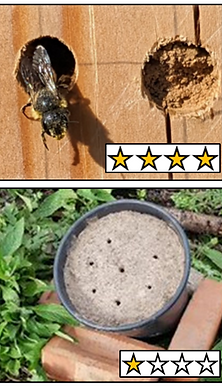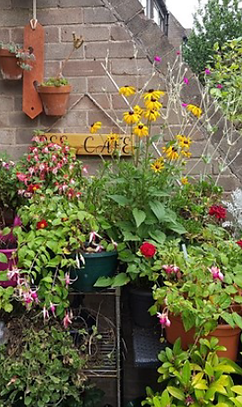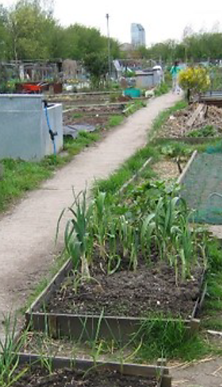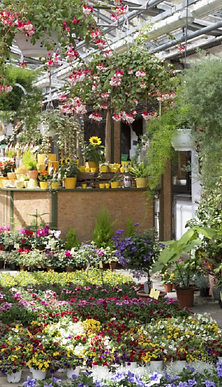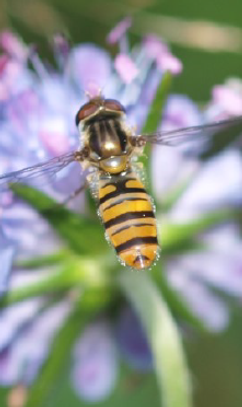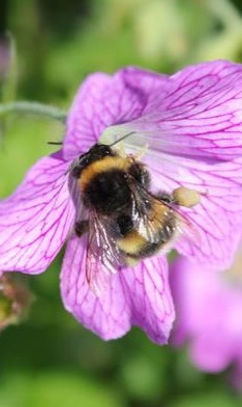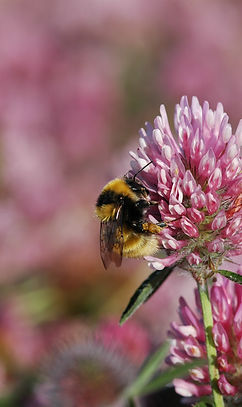

Issue 16 (Dec 2023)
2023 was a year of changes for the Buzz Club, with Issy joining the team and a big overhaul of the website. We kicked off our webinar series; introduced more Members' groups and got to grips with social media; all alongside our projects and outreach work.
Find out more in this newsletter, with results from the first year of Air Bee 'n Bee, the Insect ID Quiz and Bees & Heatwaves; updates from ongoing projects, and the first run of our shorter Snapshots. Plus Marvelous Miners, which showed very clearly how not to make a hotel for digger bees!
In publications, Dave and Rosemary Perkins dive into the environmental impacts of spot-on treatments; Beth and Janine look at plant-pollinator interactions in urban growing spaces; and Janine goes So Wild! again, investigating how to get the best value data out of citizen science projects.
Issue 15 (Dec 2022)
The impacts of the July 2022 heatwave were tough across the UK, but our volunteers persisted and the 2022 newsletter is now out, with updates to all our projects! Alongside all that, Dave and Linda tested out different bee hotel ideas; Janine showed attendees of the XXVI International Conference of Entomology how citizen science is Sow Wild! and Ellie went on the hunt for free-range hoverfly lagoons. Plus we introduce a new database from Sussex about UK pollinators and what plants they visit.
Issue 14 (Nov 2021)
Some things are back to normal, some are very far from it, but the efforts of Buzz Club volunteers continue to be fantastic!
The first outing of new project Earwi'GO! was successful, recording visits of at least 1000 earwigs to our different 'hotels', and showing a definite preference for certain fillings. The second year of Polli-Nightors expanded to cover more sites of nocturnal insect activity (only some of which were Linda's bathroom wall). Hoverfly Lagoons investigated alternative lagoon containers, and reports the first description of a pupal stage, found in this project. The Garden Shop Calculator proved particularly lucrative for apple-growers, and Strawberries Rock! wrapped up with a lot of lessons learned.
We also have two wider update articles in this issue. First, Janine Griffiths-Lee discuses the pollinator potential of mini wildflower meadows; then Dave Goulson writes about why we should ban urban and garden pesticides, following on from the publication of his book 'Silent Earth'.
Issue 13 (Oct 2020)
A challeging year, but massive thanks to our members who have found time to take part in our 2020 projects.
The new Polli-Nightors project introduced members to the nighttime residents of their gardens. Hoverfly lagoons found a new species and alternative uses for comfrey; while the Garden Shop successfully tried out more allotment-friendly measurements. Strawberries Rock! has close observations of fruit thieves, and the Bee Café provded a lockdown-friendly way of supporting pollinators.
We also look at two papers published this year from Buzz-Club associated projects; and the digital adventures of Dave.
Issue 12 (Oct 2019)

In our end-of-the-decade newsletter, the Buzz Club hits over 200 members and Dave's latest book invites you to the Garden Jungle.
Results from Strawberries Rock! show interesting potential, so will be expanded next year. Dave and Rosi Rollings investigate which plants are best for attracting pollinators to your garden, and we give reccomendations and a link to the full paper. Hoverfly lagoons champions cut grass, and Slowing Slugs compares home remedies for pest control.
Issue 11 (Jun 2018)
'Buzzing Balconies' wins its funding bid, thanks to Tesco shoppers, and volunteers pick up strawberry plants and grow bags from Sussex; Claire Harkin talks us through the project and plans. Hoverfly Lagoons updates with an explanation of instars, and news of a special batch of repeats being deployed in strawberry fields this year.
It's a strawberry-heavy issue, with an update from another Buzz Team project 'Super Strawberries' - and if you have grown strawberries, the Team PollinATE and the Garden Shop Calculator would like to know! (We still would, actually)
Issue 10 (Jan 2018)

Hoverfly Lagoons makes plans for Grass vs. Leaf Lagoons
We discuss the recent news about 'Insect Armageddon' and how important volunteer data has been in identifying these issues. Beth presents results from Team Pollinate, showing how important insects are to allotment growing,
A new project 'Buzzing Balconies' is proposed as part of Tesco's 'Bags of Help' funding scheme, aiming to help people in urban areas of Brighton & Hove to learn about pollinators in even a small space. We also launch our (still running) pollinator ID Quiz.
Issue 9 (Oct 2017)
Dave further updates on pesticides found in garden centre plants, showing how this sort of research can lead to real changes being taken!
Balin Davenport introduces the Big Wasp Survey (not a Buzz Club project, but a fab bit of citizen science) and talks All Things Wasp. We reveal the winners of our photo competition, with some really gorgeous examples of insect photography. Ellie talks the ups-and-down of Lagoon Life, with predatory invaders and Batman cameos (...kind of), and encourages schools to take part.
Issue 8 (July 2017)

Hoverfly Lagoons updates its protocol and reveals previously-unknown larval behaviour. Dave reports on an investigation into 'pollinator friendly' plants and their pesticide levels (this caused quite a stir when published!), and we crowd-source identification for a Mystery Bee!
Issue 7 (Apr 2017)
Hoverfly Lagoons does some detailed analysis; Dave publishes 'Bee Quest'; and Beth kicks off a new project: Team PollinAte, investigating what pollinators are found in Brighton allotments. We also look into the size of a bumblebee's appetite, and meet the Red Mason bee to find out why it likes to live in walls.
Issue 6 (Dec 2016)
This issue sees the first outing of our fantastic new logo by the talented Ross Napier. Beth updates on her project to examine how bees find their way home (using tiny radio aerials to track bees!) and how being ill affects this behaviour, and Dave looks at the unusual, but pollinator-popular, Sicilian honey garlic.
For more seasonal fare we see how bees contribute to your festive decorating (hint: xmas wreaths would be much less colourful without them), and have another look into winter-flying bumblebees.
Issue 5 (Sept 2016)
Dave discusses problems of trying to garden for bees: a) when the very plants you buy can contain the same pesticides we want to avoid, and b) the sometimes-dubious claims of wildife 'hotel' manufacturers.
A new paper from Buzz Team members sheds light on why pollinators favour some flowers over others, and we take a look at a hugely important late-season resource for many insects: flowering ivy.
Issue 4 (June 2016)

Christina explains how non-pest insects other than bees are also affected by neonicotinoids (which Buzz Team scientists have shown are taken up by all sorts of wild plants). Dave shares his own experiences of doing Hoverfly Lagoons (even Profs have highs and lows when it comes to getting to grips with silage!); Rob updates on P.A.N.; and Beth takes us on a tour of her lab-reared bumblebee nests (with photos).
We also learn about the opportunistic Southern 'Cuckoo' Bumblee, and how it too can be outsmarted by orchids...
Issue 3 (Mar 2016)
With results updates from P.A.N., a kickoff introduction to Air Bee 'n Bee and three PhD projects (Bees 'n Beans, Sow Wild! and All About Alliums), this issue marks when several of our Buzz Club favourites got going.
Meanwhile Dave tells the woeful tale of the beautiful - but likely-doomed - Giant Golden Bumblebee, and Beth presents research into the effects of neonicotinoids on Mason bees (common residents of bee hotels). In brighter content, we are introduced to the hobbit-sounding Hairy Footed Flower Bee, and Ellie explains how overwintering in Hoverfly Lagoons works, with these hardy creatures able to survive freezing with amazing use of hard-earned fat layers.
Issue 2 (Dec 2015)
Cristina Botias presents the results of her study into pesticides in field margin wildflowers (showing an alarming level of contamination), and Dave discusses the impact of such neonicotinoid pesticides on butterflies. Meanwhile, Ellie presents the inspiration for Hoverfly Lagoons and introduces the rare Pine Hoverfly. A new bee genus is found in Portugal, and we take a look at the unusual seasonal choices of winter-flying Bumblebees.
Issue 1 (Sept 2015)
The first newsletter from the Buzz Club!
Featuring the P.A.N. project (our first project, using pan trapping to examine garden pollinators) and the first outing of Hoverfly Lagoons, Ellie tells the Lagoon Saga that led to the created of that project. Beth discuses a collaboration between the Buzz Club and a local art collective Pale Blue Dot, to explore how our food industry impacts the countryside. We also get a peak at research into the effects of planting beneficial crops around farm fields, and a detailed profile of the Ivy Bee.
